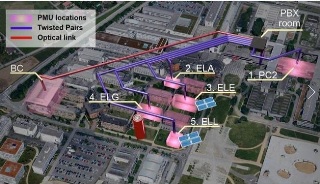Jan 12 2015
A high-performance monitoring system displays fluctuations in real-time in the power distribution grid of an entire section of the EPFL campus. This installation represents an important step towards the realistic deployment of the smart grids concept for the massive integration of renewables.
 © 2014 EPFL
© 2014 EPFL
Imagine for a moment the idea of powering a neighborhood, a city or even an entire country with solar or wind energy alone. This scenario requires nearly flawless control over what happens in our power grids. We need to be able to monitor the grid and react very quickly whenever clouds pass over the solar panels or the wind drops.
At EPFL, a sophisticated metering system developed by Mario Paolone and Jean-Yves Le Boudec represents a major step in the development of the smart grids concept. The researchers installed sophisticated sensors, called Phasor Measurement Units, in four campus buildings. The sensors are connected to a computing center where the status of the power grid is estimated with negligible time latency. Like a patient in intensive care, the building is under constant observation with its data permanently recorded. In this case it's not the heart rate and red blood cell count that are monitored, but the local voltages, phases, amplitudes and frequencies.
A global first
For its size, complexity and precision, the infrastructure built by the researchers is the first of its kind. It innovates in its use of a new kind of sensors called Phasor Measurement Unit (PMU). These devices, by means of the time-synchronisation made avalable by the GPS, measure electrical quantities called synchrophasors. In other words, measurements are made over the entire grid with the same synchronised time, and then used to estimate the system state. PMUs developed at EPFL can make high-speed measurements and map what is going on in the electrical grid. "Thanks to an advanced data processing and delivery, we can estimate the entire state of the grid with a latency of maximum 60 milliseconds," says Paolone.
For the researchers, this monitoring system is a key step in the development of the smart grid concept. Renewable energies, because they are uncontrollable and intermittent, generate considerable instability when they are injected into a grid, and this increases the risk of local blackouts. "In a smart grid, we can buffer these fluctuations through the use of batteries and supercapacitors and by using buildings as virtual storage batteries," says Paolone. "But for this we need to know exactly what's going on in the grid. Which is why our model is so useful."
An Operating System for Smart Grids
The researchers' work is far from over, however. Their model is just one part of a much larger project called "Composable Method for Real-Time Control of Active Distribution Networks with Explicit Power Setpoints", whose purpose is to develop an "operating system" for smart grids based on innovative control, communication and storage systems. It will enable applications such as intelligent building control or e-car charging to use the smart grid in a very easy way, much like the operating system in a computer allows applications to run.
Storage battery
To address the question of storage, EPFL recently acquired an advanced Leclanché Lithium-Titanate battery designed specifically for grids and able to hold up to 565 kWh. Once the battery is connected to the Romande Energie-EPFL solar park, it will be able to store surplus energy produced when the sun is strong and then feed the electricity into the grid very quickly at times of peak demand or when the sun stops shining. "One of the tasks of our monitoring system will be to pilot this battery," says Le Boudec. The researchers are also studying the possibility of using an entire building as a virtual battery. The building's energy consumption could be managed - by changing its heating parameters, for example - in order to absorb surplus electricity.
A solar building already operational
For now, most communication and storage tests are run on virtual models. But an increasing number of dedicated tests are being carried out on some of the school's buildings.
For example, Paolone equipped the building he works in with solar panels whose output is controlled and managed by a smart microgrid. Combined with the Leclanché battery, this system allows the building to run on solar energy alone. The researchers will also test their virtual storage battery system on the newly built mechanics hall on campus.
"We are developing realistic-scale models that can be scaled up easily," says Le Boudec. "Our goal is to install our models across the campus to make the EPFL independent of the traditional electrical power grid."